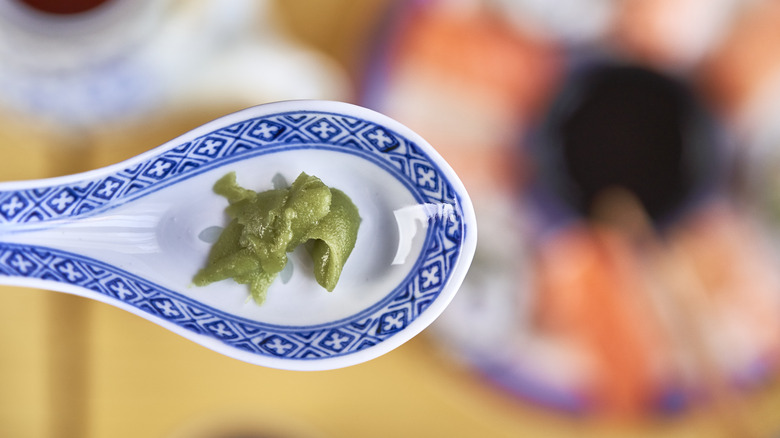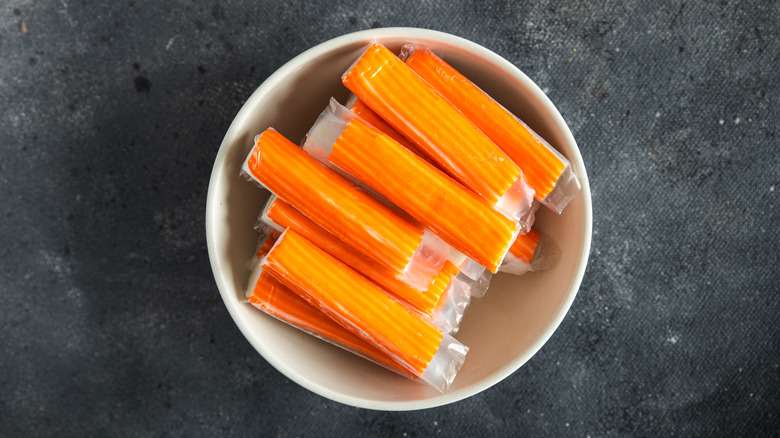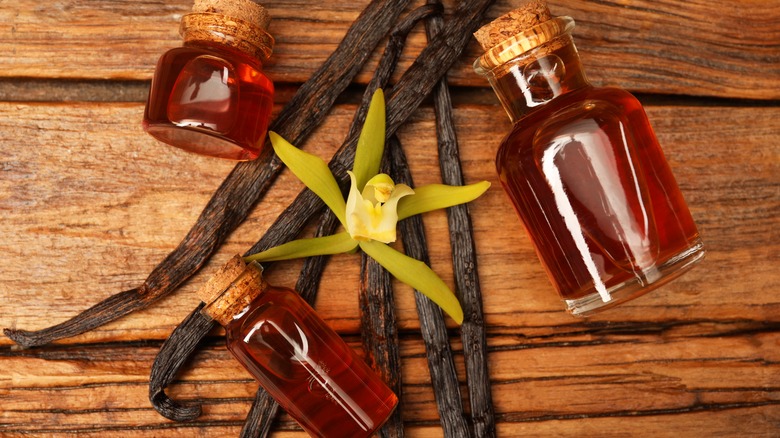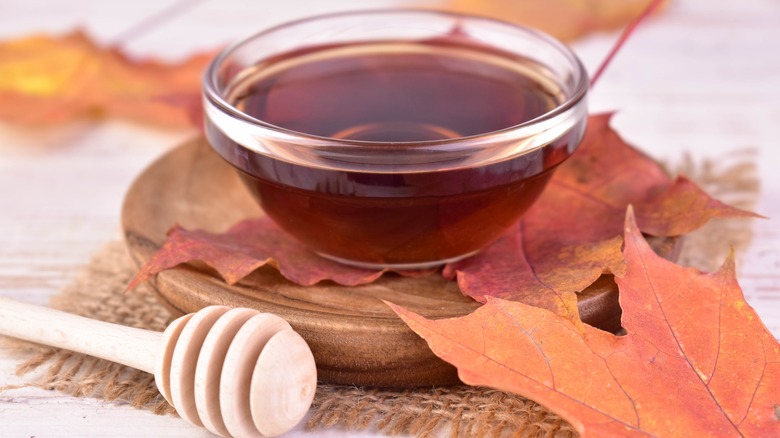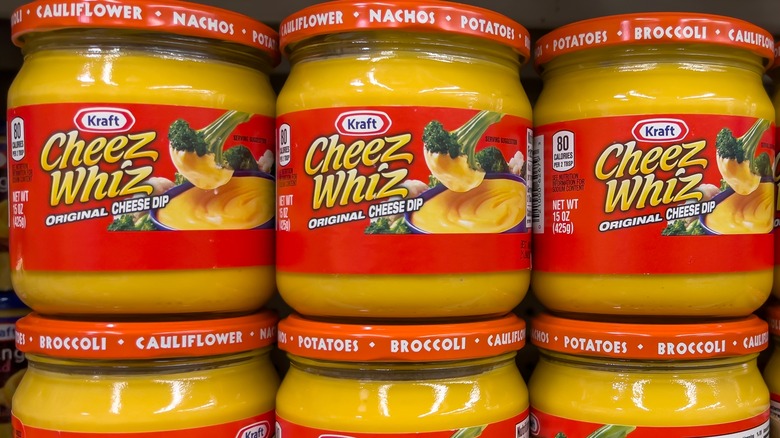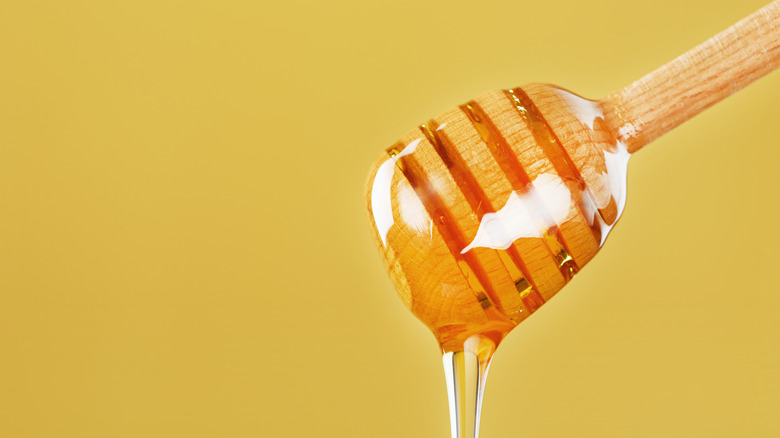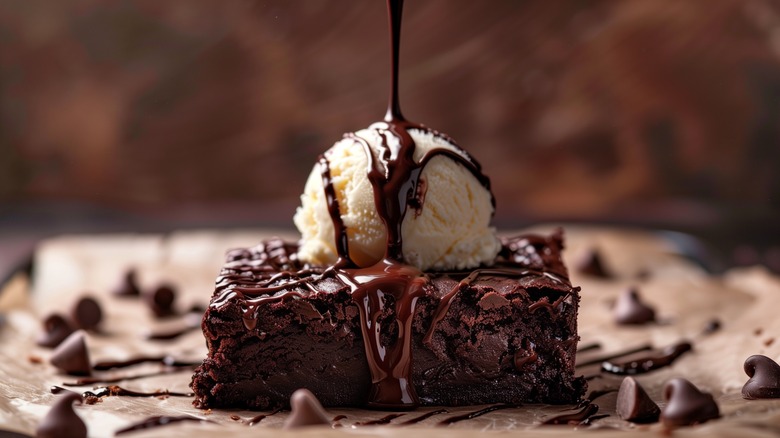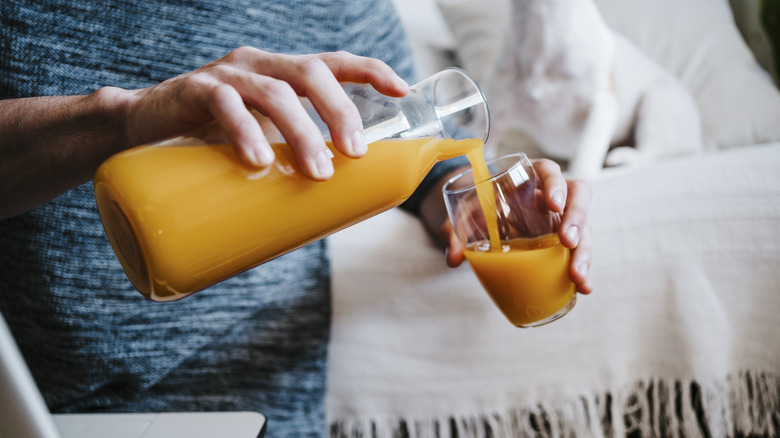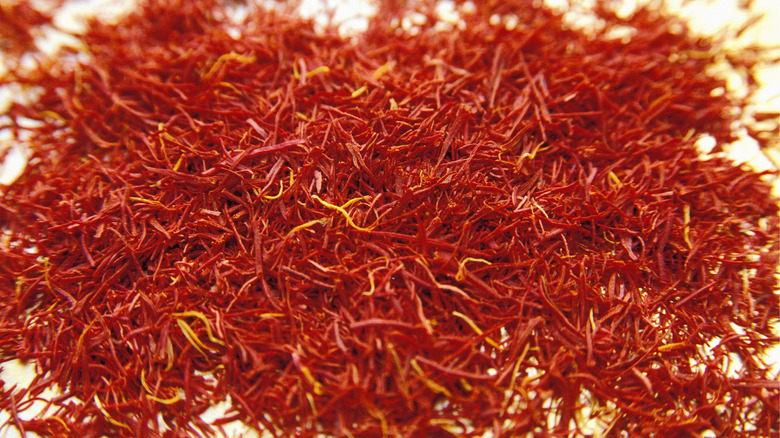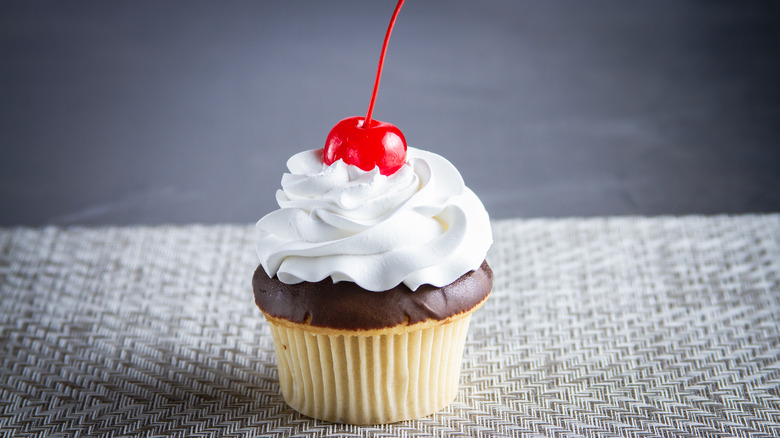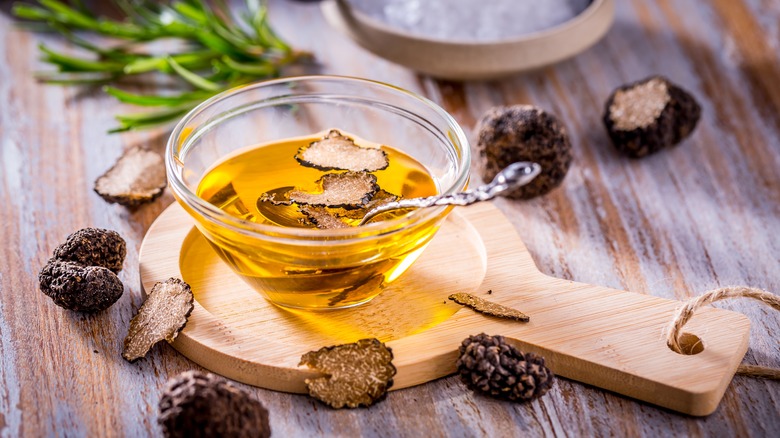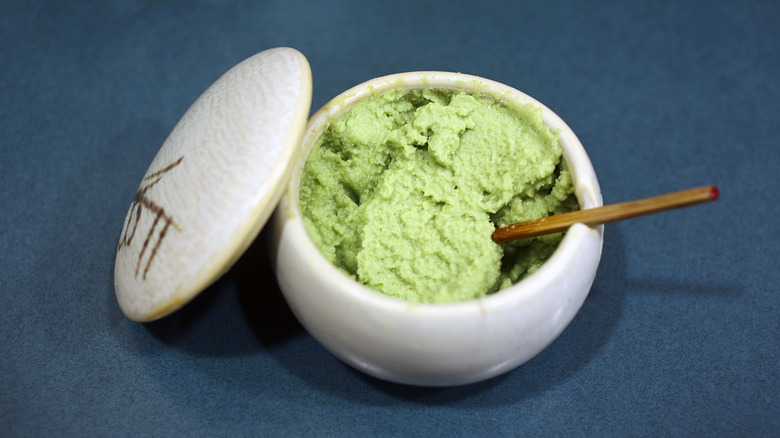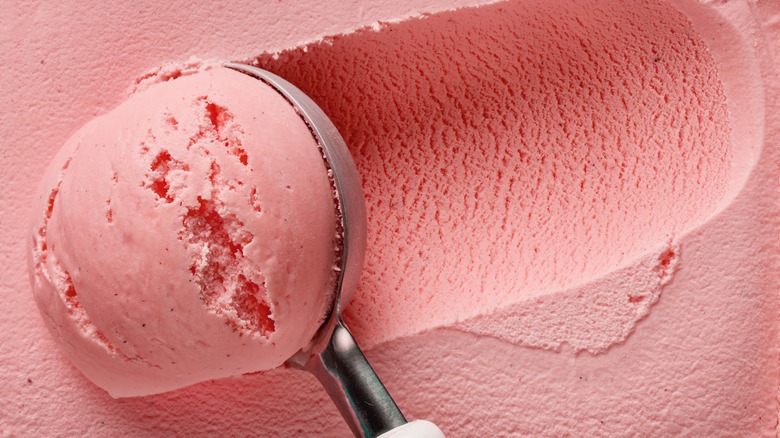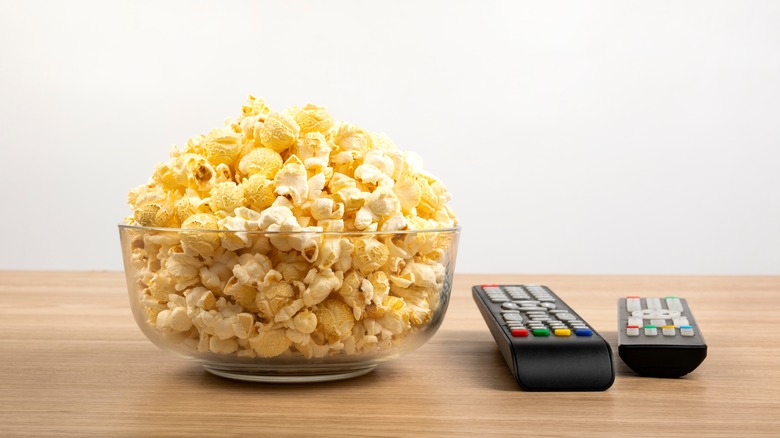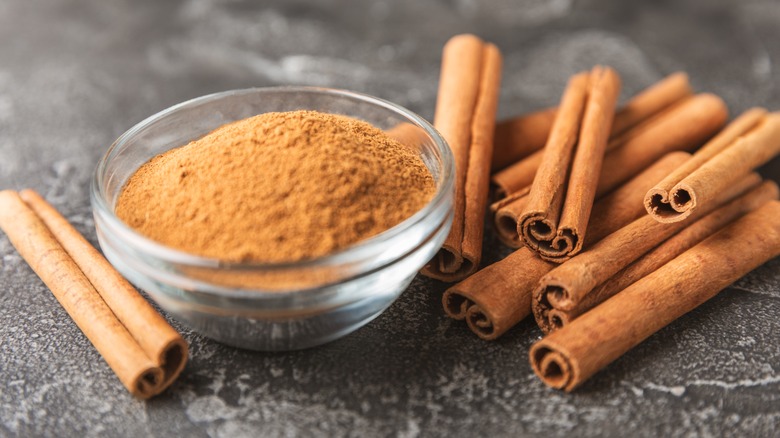14 'Fake' Foods You Probably Have Hiding In Your Kitchen
There are a lot of fake foods out there. Whether as a result of imitation or genuine food fraud — a surprisingly big problem that the FDA says affects approximately 1% of the world's food — lookalike and taste-alike foods are everywhere. It's difficult to know these days whether what we're eating is the real deal, which isn't helped by the rise of technological advancements when it comes to food. This has allowed a lot of false items to pass as the genuine article and end up in our kitchen.
Fake foods have flourished in a market where people are having to make hard choices about where they spend their money. These foods are often way less expensive than the real version, and seem to offer the same taste at a reduced cost — before you get them home, and realize that they don't hold a candle to the real thing. Fake foods are more widespread than you might think, too. Some of our favorite food products out there, from syrups to spices and extracts to dairy products, are as false as they come. We're here to expose the impostors that are hiding in plain sight, right in your pantry.
1. Crab sticks
Imitation crab has to be one of the most common imitation foods out there — and yet, it's amazing how few people know that their crab sticks aren't the real deal. Imitation crab is typically made from Alaska pollock which is ground into a smooth paste. Various ingredients are added to this paste to make it more crab-like, with higher-end products containing natural flavors that can make the eventual sticks taste authentic. However, the cheaper versions tend to have an assortment of less-classy ingredients, with salt, sugar, and starch added to them.
The paste is then formed into stick shapes and adorned with red food dye, which makes the sticks look more like genuine crab legs. The flavor is somewhat reminiscent of crab's gentle, slightly salty notes. However, it can also be noticeably sweeter and taste a little cloying.
You can generally tell that imitation crab sticks aren't the real deal by their price: This fake product is way cheaper than real crab meat. A thorough inspection of the package will also quickly reveal that these sticks are made from a fish "product," instead of crab itself. If you're less familiar with seafood products, though, it's easy to buy these without realizing they're made from fish paste. Yum.
2. Vanilla extract
If you have vanilla extract in your pantry — and most of us do — it's likely that it's not the real deal. Imitation vanilla extract is widespread thanks to its lower price point, and manufacturers have gotten pretty good at making it almost indistinguishable from real vanilla extract. Vanilla extract is made from cured, ground vanilla beans that have been soaked in a combination of alcohol and water, which extracts vanillin, the compound that gives you that vanilla taste. Conversely, the imitation stuff can be made from an assortment of different ingredients, but commonly has an artificial starting point.
Because imitation and real vanilla extract taste so similar, you may not be able to tell them apart in certain uses. In baked goods the flavor difference is virtually nonexistent, and you can swap them to your heart's content. However, if you're using vanilla extract in a no-cook dish, you'll likely find that real vanilla gives you a way better flavor. It's also important to remember that real vanilla extract may also contain other ingredients than just vanilla, alcohol, and water. Some brands can add sugar or corn syrup to their formulations, which may alter the taste.
3. Maple syrup
Real maple syrup can be surprisingly difficult to buy. This breakfast staple is commonly imitated by prominent food manufacturers who market and brand their own syrups in ways that make them hard to tell apart. Real maple syrup is made by following a stringent production process, involving tapping maple trees when they're in-season and boiling down its sap. The syrup is then classified by its color, with darker syrups being stronger and sweeter.
On the other hand, imitation maple syrups don't have such a strict production method. Instead, these syrups make a maple-like syrup from sugar and various other sweeteners, and add a touch of artificial food coloring to give it a caramel hue. Generally, these syrups will be branded in such a way that they could pass as maple syrup, but are instead called "breakfast syrup" or "pancake syrup."
To tell whether your maple syrup is the real deal, you should look out for certain ingredients and classifications on the bottle. Real maple syrup will usually have "Grade A" on the bottle, which indicates that it's of a certain quality and has no more than 68.9% solids by weight. Maple syrups will also commonly have "maple sugar" listed on their bottles.
4. Cheese products
It's probably little surprise to some people that certain cheese spreads and products are devoid of the real stuff. However, they still manage to fool some folks. Imitation cheese products like Cheez Whiz might have a cheesy flavor, but they don't actually have any cheese in them. Instead, they're made by taking some of the components of cheese, like whey, milk, and cheese culture, and mixing them together with a host of other additives and flavorings to improve their shelf-life and color.
Unfortunately, this can also result in weird artificial flavor that's a far cry from the real thing. With Cheez Whiz in particular, this wasn't always the case. Kraft's flagship cheese spread product was originally formulated with cheese in it, until the company quietly altered things. While there might be some traces of cheese still lurking in there somewhere, it's not enough to put on the label. Other cheese products like Velveeta may be more solid than Cheez Whiz and other similar spreads, but they're also technically not classified as cheese and are instead sold as "cheese products." If you want the real thing, look for items that are explicitly sold as cheese and which contain minimal ingredients.
5. Honey
How do you know that your honey is actually honey? It may be way simpler than you think — but requires you to pay close attention to what you're buying. Some products look, smell, and taste just like real honey, but are actually fake. That's because fake honeys (which are pretty widespread) contain additional sugars that aren't derived from bees, like glucose or corn syrup.
These sugars may be listed on its ingredients list, but they can also sneak their way into products branded as "honey," with manufacturers adding in syrups to keep costs down. If you want the real deal, you should look for raw or filtered honey made by reputable producers. Both of these honeys come directly from bees and don't have anything added to them, but filtered honey goes through a little extra processing to remove any particles or air bubbles that might cause the liquid to crystallize more quickly. If you're in any doubt as to whether your honey's real or not, dropping a spoonful into some water can give it away. Honey that begins to quickly dissolve is likely cut with something else, while honey that sinks to the bottom is the genuine article.
6. Chocolate flavor syrup
Buying chocolate syrup that's actually made of chocolate is harder than it looks. A surprising amount of products out there don't actually have any chocolate in them at all, and are instead imbued with chocolate flavor to imitate its taste. This is the case with some of the most well-known chocolate syrups out there. You might expect Hershey's Chocolate Syrup, for example, to contain chocolate (given that it's made by Hershey's and all), but it's conspicuously branded as having "genuine chocolate flavor." Take a closer look at the ingredients list, and that chocolate flavor comes from cocoa, with the product's syrupy nature coming from high fructose corn syrup.
Now, this might all sound like we're nitpicking, but it makes quite a big difference. Cocoa is an essential ingredient that gives chocolate much of its flavor, but it isn't actually chocolate in its own right. When isolated from the chocolate and combined with ultra-sugary ingredients, it loses its smoothness and richness and instead tastes overly sweet. Instead, you should try and find products labelled as "chocolate sauce" which have chocolate as a separate ingredient, or make your own chocolate sauce from scratch.
7. Fruit juice
Even the most simple of food items can be imitated and faked. If you don't believe us, take a look at the label for your favorite fruit juice. These juices are notorious for playing up their juicy, fruit-containing status, and then including ingredients that are anything but juice itself. Take something like Minute Maid's Fruit Punch, for instance. Sure, the product says that it is made with real fruit juices, but it also contains sucralose, natural flavors, and high fructose corn syrup. Not exactly just the fresh juice squeezed straight from the natural produce, then.
Even fruit juices that market themselves as having "100% fruit juice" are slightly faking what's inside them. Ocean Spray 100% Cranberry Elderberry Juice may not have any added sugar, but it does contain vegetable concentrate, natural flavor, and various types of acids. If you want the closest thing you can get to a real fruit juice, you either need to juice your own fruits or find an organic option. Organic fruit juices may still contain ingredients like added vitamin C, but they tend not to be made from concentrates and usually give you the purest fruit juice possible.
8. Saffron
Saffron is an expensive spice, with its cost driven up by its slow production process. The reason saffron is so expensive is because saffron crops produce relatively small amounts, and the spice is harvested by hand-picking the stigma of the crocus flower. These stigmas are then worked through manually to make sure each one is intact and worthy of selling. Unfortunately, this has led to a host of rogue sellers creating fake saffron threads, which initially look the same as the real thing but which likely won't imbue your food with the same delicate flavor.
Unless you cook regularly with saffron (and given its price of $10-20 per gram, we wouldn't be surprised if you didn't), it can be hard to tell whether yours is fake or not. However, one of the best ways of telling is by popping a few of your threads into some water. If the saffron is genuine, the water will eventually turn a golden yellow color. On the other hand, fake saffron won't create the same color change, and you'll find that your water stays the same or is only slightly tinted. Naturally, this is a test that you can only do once you've already bought it, so the best way of ensuring that your saffron's real is to buy from a reputable seller, and to not get fooled by a price that's too good to be true.
9. Whipped topping
"Whipped topping" and "whipped cream" may look similar, and taste similar — but they're not the same thing. We generally expect whipped toppings like Cool Whip to be whipped cream by any other name, but they contain far more ingredients than just cream or dairy. Instead, Cool Whip is primarily made from a combination of hydrogenated vegetable oils, corn syrup and high fructose corn syrup, natural and artificial flavors, various gums, and food starch.
There is dairy in Cool Whip, in the form of skim milk and light cream — but the latter shows up in less than a 2% quantity. This is at least an improvement from its original recipe, which didn't contain any cream or milk whatsoever. Other whipped toppings contain similar formulations, with some of them having no dairy ingredients at all, despite looking just like whipped cream. By contrast, products sold as whipped or whipping cream will generally have cream as their primary ingredient. While they may have other things mixed in, it's best to seek out whipped cream products that are as simple as possible, so that you can flavor them yourself and avoid excessive amounts of sugar.
10. Truffle oil
Truffle oil is one of those foods that gives any dish a touch of luxury. However, you might be surprised to hear that the truffle oil you have in your kitchen doesn't have any truffles in it whatsoever. Most truffle oils out there don't contain real truffles, which are found by following a painstaking process of using specially-trained dogs to sniff out the subterranean food. Because hunting for truffles takes so long and is so costly, it's no surprise that truffle oil producers want to make things simpler for themselves.
As such, truffle oil manufacturers add a chemical called 2,4 dithiapentane to regular oil, which is a synthetic compound that's formulated to smell like truffles. While it might sometimes do the trick, this synthetic stuff can often create an oil that smells and tastes way too pungent. If you're ever had a meal totally overpowered by the flavor of truffle oil, it's likely because of this chemical. If in any doubt about whether your truffle oil is an imitator or not, look out for the inclusion of "truffle flavoring" or "truffle aroma" on the ingredients list — these descriptors likely mean the product is a fake.
11. Wasabi
If you have wasabi in your kitchen, it's likely that it's not the real thing. The way you'll know this? If it is genuine, you'll only have about 15 minutes to enjoy it. The pungent flavor of real wasabi, which is derived from the stems of the plant, is unlocked when it's grated into a fine paste. However, once the wasabi is exposed to the oxygen and moisture in the air, its flavor compounds start to degrade incredibly quickly. Within about a quarter of an hour, that sharp, spicy wasabi will taste way flatter — and it'll only continue to get less fiery and flavorful as time goes on.
Because wasabi doesn't keep well at all, food manufacturers all around the world have figured out how to emulate it while ensuring their product has a long shelf-life. The solution most of them have landed on is to sell a combination of horseradish, Chinese mustard, green food coloring, and various other ingredients. These all come together to look and taste like wasabi, with the horseradish emulating it effectively (although it's generally less hot and slightly sweeter). If you want to taste the real thing, you'll likely have to seek out a restaurant that grates it fresh before each order.
12. Frozen dessert
You may not be that bothered about whether your frozen treat is ice cream or a frozen dessert, as long as it tastes good. However, it's important to know that the two things are not the same, and that frozen dessert is kind of an imitation product. Ice cream is classified by its being made from primarily dairy products, whereas frozen desserts are made with a way wider selection of ingredients. Frozen desserts can often be primarily composed of vegetable oils, unlike icecream, which gets its creaminess and richness from milk solids and milkfat. These two ingredients must make up 20% and 10% of ice cream's formulation respectively, according to the USDA, while there are no such standards for frozen desserts.
Frozen desserts can also often have a host of other items in their blends, like gums, emulsifiers, and even flours that bulk them out. All of these things may result in a dessert that's delicious and flavorful, but it's certainly not the unadorned, pure ice cream you're likely looking for. Having said this, many cheaper ice creams can also be chock-full of added ingredients, but at least you can be sure they're working from a cream and milk base. However, it's always best to look for ice creams that are made from a few high-quality ingredients.
13. Butter popcorn
Butter popcorn may be a must-have in your pantry, but don't expect that snack to have any actual butter in it. Unless you're literally melting butter and pouring it over the naked kernels yourself, it's likely that you're instead consuming popcorn that's been coated with a "butter flavor," as opposed to the real thing. These popcorn products will instead get their fatty notes from palm oil or another type of vegetable oil, and the flavor is produced by isolating certain compounds – these compounds may come from butter, but they may also come from another source entirely.
Importantly, some popcorn brands do list butter on their ingredients lists, but it can vary significantly from product to product. The stuff that's on the market now is way better than what used to be sold, though. Butter flavoring used to be supplied by an unexpectedly deadly chemical known as diacetyl, which released dangerous fumes that significantly affected factory workers who produced it. Once the scale of the problem was fully realized, food manufacturers switched away from using diacetyl, and now use alternative products to flavor their popcorn.
14. Cinnamon
You can't even trust your spice rack these days, guys. Even some of the most innocuous spices out there, like cinnamon, may not be the real thing. Products sold as cinnamon sticks are commonly not actually true cinnamon, or ceylon soft bark cinnamon, which is made from real cinnamon tree bark. Instead, food manufacturers often use bark from the cassia tree, which grows way more abundantly and so is cheaper to produce.
Chances are you might not be able to tell the difference, though. Cassia and ceylon cinnamon look almost identical to each other, and taste pretty similar too — and they're close enough to be both sold as "cinnamon" in stores without any issues. However, it's worth noting that true ceylon cinnamon generally has a spicier, more intense flavor than cassia. If you want real ceylon cinnamon, you'll have to hunt out food manufacturers that explicitly state that they use it in their products. You can also buy ceylon soft bark cinnamon and grind it at home, using a spice grinder, to ensure that you're getting the genuine article.
